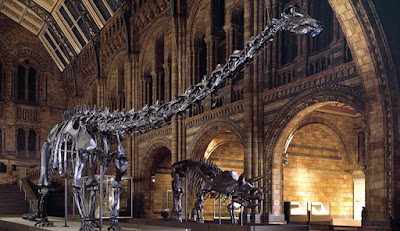If like me and my
children, you love going to museums, you're bound to have a favourite. For me
it's Bowes Museum near Barnard Castle: http://thebowesmuseum.org.uk/ ,because it has such a brilliant variety
of treasures from the past; everything thing from a silver swan automaton which
preens itself every hour, to incredible dresses and rare works of art. My
eldest daughter's favourite is The Natural History Museum: http://www.nhm.ac.uk/She will go back to
it time and again and I'm sure it is because we visited when she was young and
she fell in the love with it. At the time she was obsessed with dinosaurs and
enjoyed putting her large collection of plastic dinosaurs on display at home.
Which leads me on to making museums at home.
Most children love
collecting and sorting, which makes creating a home-based museum a very
engaging activity. These items can be anything: toy cars, shells, Lego models,
anything that interests your child. Your museum could be as small as you want;
just the top of a book case for an Autumn museum for example, with a temporary
display of Autumn finds.
A historically themed mini-museum, such as the Ancient
Egyptians could lead to making models and artefacts.
You could begin
with a visit to a local museum and discuss what is there, how it is set out,
what they enjoyed finding out about. Then all you really need to make a museum
at home is paper, cards and pens and a collection of items, or artefacts!
Start with deciding
how to display the items; perhaps in boxes with cut outs to look into or on
some shelf space that has been cleared.
Now for exhibition
labels, perhaps on small folded cards, describing what the artefacts are. This
is a good way to support some research, as well as practising factual writing.
Encourage your child to to be precise, including the name, dates and other
relevant information, rather than opinions, such as “This is the best
dinosaur.”
For example:
T-Rex was a carnivorous
dinosaur which lived in western North America
68 to 66 million years ago.
It weighed up to 14 tons and
was 12 metres long.
Fascinating fact: Tyrannosaurus Rex had the strongest bite of
any animal ever discovered.
Another writing
route is to create a leaflet all about their museum. Discuss what they'd need
to include: a brief description of the
museum, opening times, facilities, location and so on. Leaflets are a great way
to encourage paragraph writing, sub-headings and captions. A map could be
included on the back. Using ICT can lead to colourful and professional looking
leaflets.
Finally, your child
might also like to take on the role of a museum guide, showing visitors around
the exhibits and telling exciting stories about where the artefacts were found.
So as the nights
draw in and the weather keeps us indoors, fashioning a museum out of treasured
possessions can be a lovely way to spend a wet day. If making a museum seems a
bit daunting however, you could always help your child turn their books into a
library. We still have a few of the books from my husband's library he created
when he was nine, all catalogued and with pockets for the lending tickets! See my previous post 'Making Books'
https://blackheneducation.blogspot.co.uk/2017/02/
https://blackheneducation.blogspot.co.uk/2017/02/
Whatever your
child's interests, I hope you have lots of fun creating your mini-museums. We
would love to see photos of your finished museums at Blackhen too!
This post was written by Bernadette Whiteley, a KS2 & KS3 English tutor at Blackhen Education.
This post was written by Bernadette Whiteley, a KS2 & KS3 English tutor at Blackhen Education.



No comments:
Post a Comment